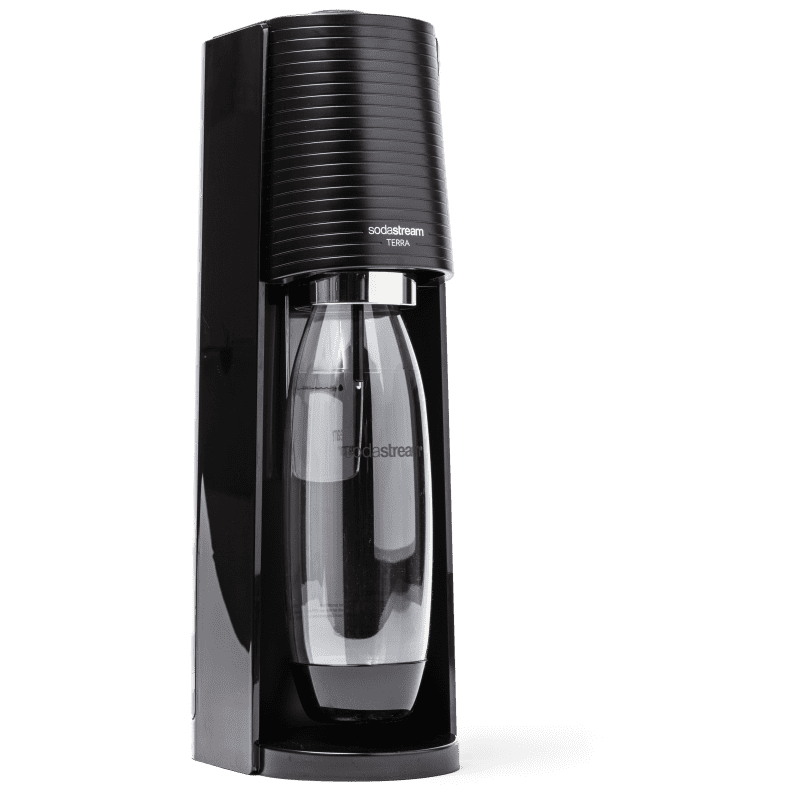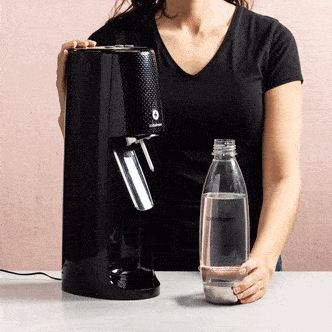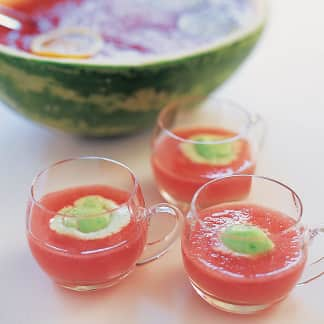The best soda makers carbonate water quickly, easily, and effectively. They sit stably on the counter, and their water bottles are convenient to drink from and store. We’ve designated four winning models. The SodaStream Terra is our all-around top pick; it’s great for most people. The Breville InFizz Fusion is our upgrade pick; its stylish stainless-steel design and ability to carbonate liquids besides water make it a great investment. If you prefer glass water bottles to plastic, we recommend the automatic SodaStream E-Duo, which works with both bottle types. And if you’d rather skip the carbonating bottles, our recommended dispenser-style model, the Ninja Thirsti Drink System, carbonates water from a tank before dispensing it directly into your glass. It allows you to customize carbonation levels, flavorings, and more. The only downside? It operates much more slowly than our other favorites.
A Breakdown of the Winners
The Soda Maker | The Soda Maker  Best for Most People SodaStream Terra Buy on Amazon ▸ | The Soda Maker  Best Machine with Glass Bottles SodaStream E-DuoBuy on Williams Sonoma ▸ | The Soda Maker  Ninja Thirsti Sparkling & Still Drink SystemBuy on Amazon ▸ Ninja Thirsti Sparkling & Still Drink SystemBuy on Amazon ▸ | The Soda Maker  Upgrade Pick Breville InFizz FusionBuy on Amazon ▸ |
|---|---|---|---|---|
Carbonation Source | Carbonation Source 60-liter “quick connect” CO2 canisters | Carbonation Source 60-liter “quick connect” CO2 canisters | Carbonation Source 60-liter CO2 screw-in canisters | Carbonation Source 60-liter CO2 Canisters |
Type of Water Bottle | Type of Water Bottle Plastic (dishwasher-safe) | Type of Water Bottle Glass and plastic (both dishwasher-safe) | Type of Water Bottle External tank | Type of Water Bottle Plastic (must be hand-washed) |
How It Works | How It Works Manually, by repeatedly pressing a button | How It Works Automatically, by pressing a button that corresponds to a preprogrammed carbonation (low, medium, high) | How It Works Automatically, by customizing water volume, carbonation strength, and optional flavorings | How It Works Manually, by repeatedly pressing a lever |
Can It Carbonate Liquids Other Than Water? | Can It Carbonate Liquids Other Than Water? no | Can It Carbonate Liquids Other Than Water? no | Can It Carbonate Liquids Other Than Water? no | Can It Carbonate Liquids Other Than Water? yes |
Does It Require Electricity? | Does It Require Electricity? no | Does It Require Electricity? yes | Does It Require Electricity? yes | Does It Require Electricity? no |
Dimensions of Machine | Dimensions of Machine 7½ x 5 x 16¾ in | Dimensions of Machine 13 x 6 x 17 in | Dimensions of Machine 14 x 8 x 16 in | Dimensions of Machine 10 x 6 x 16½ in |
To turn regular tap water into carbonated water at home, you need to add carbon dioxide (CO2). There are four main types of soda makers, each with a different method for accomplishing this goal.
The first (and most popular) group of machines employs tall, slim CO2 canisters that hold enough gas to carbonate about 60 liters of water. These machines are sold with reusable water bottles that are unique to each specific model. Many bottles are plastic, but one machine comes with dishwasher-safe glass bottles. To operate this style of soda maker, you fill the water bottles with cold water and attach them to the machines. Many of the models we tested are manually operated (you repeatedly press a button or lever until you get the amount of carbonation you prefer), while a few are automatic (you choose from a selection of preprogrammed carbonation settings). The automatic machines are electric and must be plugged into an outlet for you to operate them.


With manual models (left), you have to repeatedly press a button or pull a lever until you get the amount of carbonation you want. Automatic models (right) are a little easier to use because you just a press a button that corresponds to preprogrammed carbonation settings.
The second group of soda makers uses the same multi-serving CO2 cylinders but draws water from external tanks (similar to those from single-serve automatic coffee makers) and mixes that water with CO2 before dispensing it into your chosen vessel. We call these devices “dispenser-style” machines. The third group doesn’t use bottled CO2 at all and instead relies on small packets of powdered citric acid and sodium bicarbonate, which, when mixed with water, create CO2. There is also a fourth category of soda makers, known as soda siphons. These devices require tiny single-use CO2 cartridges to operate. We’ve found this style of machine imprecise, and we think it’s a nuisance to buy, store, and dispose of all those tiny cartridges, so we didn’t include any in this review.

What To Look For
- A Machine That Uses 60-Liter CO2 Canisters: We prefer models that use tall, slim CO2 canisters that contain enough gas to carbonate dozens of bottles of water. They’re generally marketed as 60-liter canisters because manufacturers estimate that each one can carbonate 60 liters of water—though that number depends on how bubbly you like your water.
- Sturdy Construction: With machines that employ reusable bottles, pressure builds up inside the water bottles as you add carbonation, so you want a machine that feels sturdy and secure. On one model, the bit of plastic that cradled the water bottle was thin and felt flimsy. It wiggled slightly when we attached or removed the water bottle and didn't feel secure. Solid construction was also important for dispenser-style machines. The best machines were heavy enough to stay put on the counter when we removed and installed their water tanks, preventing us from sloshing or spilling water.

- Conveniently Sized Water Bottle: The water bottles of most of our favorite models were roughly the same size and shape as a 1-liter water or soda bottle. One model’s bottle was more than 14 inches tall and very narrow, which made it difficult to store in our refrigerator and awkward to drink from.
What To Avoid
- Machines That Use Powders to Carbonate: We were intrigued by the concept of using packets of powdered citric acid and sodium bicarbonate to produce CO2. You empty the contents of one set of packets into a hole in the top of the machine. Once activated, the machine adds water, which is held in a separate sealed chamber, to the citric acid and sodium bicarbonate powder, and the resulting CO2 is then directed into the bottom of your water bottle. When the carbonation cycle is complete, you remove your water bottle and empty the wastewater bin. It was annoying to fill the water chamber and empty the wastewater bin each time we carbonated a bottle of water, and the machine was slow and ineffective. It took 4 full minutes to carbonate a bottle at the highest setting, compared with just a few seconds for every other model. Even at the machine’s highest setting, the water was not as fizzy as water carbonated by other models.

Soda makers typically use CO2 gas to produce carbonation. One of the models we tested used packets of citric acid and sodium bicarbonate powder instead, but it took longer to carbonate and the soda was not as fizzy as water carbonated in other machines.
Other Considerations
- Plastic versus Glass Water Bottles: Many soda makers come with plastic water bottles. Repeated use and exposure to heat can weaken the plastic, so manufacturers typically recommend washing the bottles by hand, though a few models came with plastic bottles that are dishwasher-safe. Even if you take care when using them, the vast majority of plastic bottles eventually need to be replaced. (On the sides of the plastic bottles we tested, we found expiration dates ranging from about two to four years after the dates we purchased the machines.) One machine in our lineup is equipped with a glass water bottle that can be cleaned in the dishwasher (though it’s a good idea to exercise care when using and cleaning any glass kitchen equipment). Glass water bottles are good options for anyone who prefers to avoid plastic or doesn’t want to worry about replacing the bottles in time; the trade-off for the model we tested is that its glass bottle is heavier and several ounces smaller than the plastic bottles in our lineup.

- Carbonating Caps and Slow Pressure Release: Several of the models had special carbonating caps. You fill the water bottle, screw on the carbonating cap, and then attach the bottle to the machine. After the water is carbonated, you remove the bottle and sometimes give it a shake to create a bit more carbonation. Next, you press a valve or give the cap a quarter twist to slowly release the pressure that’s built up inside the bottle. With other models, you attach the bottle to the machine without a cap and the water is ready to drink right away; there’s no need to shake or release pressure. Both systems can produce great results. Models without carbonating caps are simpler to use. But while models with caps often have a slightly steeper learning curve and require a few extra steps to complete the carbonation process, none are truly onerous to use. And many often come with an added benefit: The pressure-release systems built into the carbonation caps often mean that they can carbonate liquids other than water.
- Manual versus Automatic Machines: Manual machines require users to repeatedly press buttons or levers to carbonate water to their desired level, which can be personalized anywhere on the spectrum from lightly effervescent to very bubbly. They don’t need to be plugged into an electrical outlet. Automatic machines have several preprogrammed settings (corresponding to low, medium, and high carbonation) and require only gently pressing a button twice. They require electricity but are a good option for people with diminished hand or arm strength and anyone who wants a more hands-off, consistent option. Because each button corresponds to a certain carbonation level, you know exactly what intensity to expect. We found models in both styles that were capable of producing lightly, moderately, and heavily carbonated water.
- “Quick Connect” versus Screw-Style CO2 Canisters: There are two kinds of 60-liter CO2 canisters. The older kind twists into place, using a motion similar to screwing a light bulb into place. The newer kind uses a “quick connect” mechanism that doesn’t require any twisting. Instead, you slide the canister onto a plastic ridge and lock it into place by pulling down a U-shaped handle. The two types are not interchangeable, so you need to take care that you’re selecting the right style when purchasing or exchanging a CO2 canister.
- Dispenser-Style Machines: We liked that dispenser-style machines had external water tanks and dispensed into our own glasses and cups so that we didn’t have to buy, store, and clean brand-specific bottles to carbonate water. The dispensers’ 48-ounce external tanks were also larger than the 1-liter (about 34 ounces) bottles from other brands, so the tanks required fewer refills overall. These machines do have some drawbacks; they’re slightly bulkier and more expensive than many of the reusable-bottle machines. Overall, we think dispenser-style models are best for people who not only don’t want the fuss of using bottles but also like to have even more customization options for their drinks. Among the dispenser-style machines we tested, we preferred the Ninja Thirsti Sparkling & Still Drink System over the Carbon8 One Touch Sparkling Water Maker and Dispenser. Though the Ninja Thirsti took longer to mix and dispense sparkling water, we still preferred its customizability and ease of use to the Carbon8, which was noisy and had a tank that was difficult to access and refill.
The Tests
- Carbonate cold water to low, medium, and high levels
- With compatible models, carbonate white wine
- With compatible models, carbonate cranberry juice
- Carbonate and dispense water with flavor cartridges, where applicable
How We Rated
- Ease of Use: We considered how easy it was to connect the water bottles to the machines and use the buttons or levers to carbonate the water.
- Performance: We evaluated how easy it was to adjust the carbonation levels and whether it was possible to achieve lightly, moderately, and heavily carbonated water.
- Design: We considered whether the sizes and shapes of the water bottles made them easy to use, clean, and store. We also considered the design and sturdiness of the machines, including whether carbonating caps were required.






 Buy at Williams Sonoma
Buy at Williams Sonoma






















